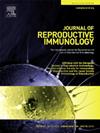Characteristics of maternal-placental vascular malperfusion and its correlation with neonatal adverse outcomes
IF 2.9
3区 医学
Q3 IMMUNOLOGY
引用次数: 0
Abstract
Introduction
Fetal growth restriction (FGR) is the failure of fetal growth to attain inherent genetic potential owing to a diverse array of factors. Limited studies have investigated the correlation between varying levels of maternal-placental vascular malperfusion (MVM)-type FGR and adverse neonatal outcomes. Thus, we sought to explore the maternal-fetal characteristics of different degrees of MVM-type FGR and their correlation with adverse neonatal outcomes.
Methods
We collected all cases of FGR from 2018 to 2023 and observed the pregnancy, delivery, and newborn characteristics of FGR cases managed by a fetal medical center. General information, clinical examinations, and neonatal outcomes were recorded. Placental lesions were sampled and classified according to the 2016 Amsterdam standard, then divided into two groups based on MVM level: low-grade and high-grade.
Results
The high-grade MVM-type FGR group (30/94) had a higher prevalence of pregnant mothers with diabetes mellitus (P=0.022) and hypertension (P=0.013), higher incidence of abnormal umbilical artery pulsatility index (UA-PI) (P=0.022) and uterine artery pulsatility index (UtA-PI) (P < 0.001), higher incidence of incomplete distal villus development (P=0.027) and placental vascular disease (P=0.008), higher incidence of cerebral hemorrhage (P=0.006) and poor outcomes (P=0.04), lower fetal weight (P=0.026), and longer hospital stays for newborns (P=0.018). Logistic regression analysis showed that body mass index (P=0.04), diabetes (P=0.033), assisted reproduction (P=0.048), pathological placental villus overmaturity (P=0.033) High-grade MVM (P=0.014) were independent risk factors for adverse neonatal outcomes, fetal birth weight (P=0.004) is an independent protective factor.
Discussion
High-grade MVM FGR is associated with the incidence rate of adverse neonatal outcomes, with a series of differences in the pre-pregnancy state, clinical auxiliary examination, and pathological characteristics compared with low grade MVM. Simultaneously, we found five independent risk factors and one protective factor that led to adverse neonatal outcomes in MVM group.
母胎盘血管灌注不良的特点及其与新生儿不良结局的关系
胎儿生长受限(FGR)是由于多种因素导致胎儿生长未能达到固有的遗传潜力。有限的研究调查了不同水平的母体-胎盘血管灌注不良(MVM)型FGR与新生儿不良结局之间的相关性。因此,我们试图探讨不同程度mvm型FGR的母胎特征及其与新生儿不良结局的相关性。方法收集2018 ~ 2023年所有FGR病例,观察某胎儿医学中心收治FGR病例的妊娠、分娩及新生儿特征。记录一般信息、临床检查和新生儿结局。根据2016年阿姆斯特丹标准对胎盘病变进行抽样分类,根据MVM水平分为低分级和高分级两组。结果高级别mvm型FGR组(30/94)孕妇合并糖尿病(P=0.022)和高血压(P=0.013)的发生率较高,脐动脉搏动指数(UA-PI)异常(P=0.022)和子宫动脉搏动指数(UtA-PI)异常(P <; 0.001)发生率较高,远端绒毛发育不全(P=0.027)和胎盘血管疾病(P=0.008)发生率较高,脑出血发生率较高(P=0.006),预后不良(P=0.04)。胎儿体重较低(P=0.026),新生儿住院时间较长(P=0.018)。Logistic回归分析显示,体重指数(P=0.04)、糖尿病(P=0.033)、辅助生殖(P=0.048)、病理性胎盘绒毛过成熟(P=0.033)、重度MVM (P=0.014)是新生儿不良结局的独立危险因素,胎儿出生体重(P=0.004)是独立保护因素。高级别MVM FGR与新生儿不良结局发生率相关,与低级别MVM相比,在孕前状态、临床辅助检查、病理特征等方面存在一系列差异。同时,我们发现了导致MVM组新生儿不良结局的5个独立危险因素和1个保护因素。
本文章由计算机程序翻译,如有差异,请以英文原文为准。
求助全文
约1分钟内获得全文
求助全文
来源期刊
CiteScore
6.30
自引率
5.90%
发文量
162
审稿时长
10.6 weeks
期刊介绍:
Affiliated with the European Society of Reproductive Immunology and with the International Society for Immunology of Reproduction
The aim of the Journal of Reproductive Immunology is to provide the critical forum for the dissemination of results from high quality research in all aspects of experimental, animal and clinical reproductive immunobiology.
This encompasses normal and pathological processes of:
* Male and Female Reproductive Tracts
* Gametogenesis and Embryogenesis
* Implantation and Placental Development
* Gestation and Parturition
* Mammary Gland and Lactation.

 求助内容:
求助内容: 应助结果提醒方式:
应助结果提醒方式:


